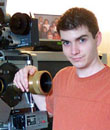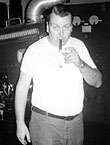|
|
This topic comprises 3 pages: 1 2 3
|
|
Author
|
Topic: Simplex PR 1050 Gate/Trap Tension
|
|
|
|
|
|
|
|
|
|
|
Monte L Fullmer
Film God

Posts: 8367
From: Nampa, Idaho, USA
Registered: Nov 2004
|
 posted 08-18-2005 04:17 PM
posted 08-18-2005 04:17 PM




is your trap and gate assembly, the flat gate style, or the curved gate variety?
If the curved gate, you'll have to watch out for excessive band wear, especially at the top of the bands where the upper loop can make contact when the film enters the trap.
I always maintain the tension knob at the "1" position for curved gates. Flat gates can be variable if needed.
Now, if you're having trouble with picture steadiness and having to send the tension up to the max, the trap and gate assembly has an adjustment for closure. And that adjustment is the gate stop allen screw located on the trap side assembly below and right of the aperture plate .
This screw is what stops the gate at a precise point.
Adjust this screw to where the gate can close a bit tighter with the setting knob at minumum to where the picture is steady and the film is actually running smooth through the assembly.
This is a step method of adjustment-by taking off the gate, adjust the screw a bit, rethread to see if steadiness is there, if not, repeat the cycle until the goal is achieved.
-Monte
| IP: Logged
|
|
|
|
Steve Guttag
We forgot the crackers Gromit!!!

Posts: 12814
From: Annapolis, MD
Registered: Dec 1999
|
 posted 08-18-2005 04:48 PM
posted 08-18-2005 04:48 PM




Nope, John was not kidding...tension should be checked on a print by print basis with the lowest tension needed to do the job. On a Simplex and Century with just 5 detented positions this might seam crude but on other brands, the tension is quite variable and in the case of a Norelco AA2, can be easily mal adjusted when the gate is opened.
As to setting gate depth as a form of tension adjustment...that is just plain silly. Generally, without binding the film, you want the gate as close to the aperture but allowing for the film to swell such that it never can blister into the aperture plate. With higher wattage lamps, about 1/8" is a good starting point, with smaller lamps a closer gap can often be had but make sure you don't bind the film as it exits or enters the gate. The closer you get the gate to the aperture (again with out binding or blistering the film) the less of a "fringe" area you will have and less bleed on the masking.
Tension bands don't come into play on this...depending on the projector, there are other tricks of the trade to get them optimised and for Simplex and Century, ideally set to "1" for most films.
| IP: Logged
|
|
|
|
|
|
|
|
|
|
|
|
|
|
|
|
|
|
All times are Central (GMT -6:00)
|
This topic comprises 3 pages: 1 2 3
|
Powered by Infopop Corporation
UBB.classicTM
6.3.1.2
The Film-Tech Forums are designed for various members related to the cinema industry to express their opinions, viewpoints and testimonials on various products, services and events based upon speculation, personal knowledge and factual information through use, therefore all views represented here allow no liability upon the publishers of this web site and the owners of said views assume no liability for any ill will resulting from these postings. The posts made here are for educational as well as entertainment purposes and as such anyone viewing this portion of the website must accept these views as statements of the author of that opinion
and agrees to release the authors from any and all liability.
|

 Home
Home
 Products
Products
 Store
Store
 Forum
Forum
 Warehouse
Warehouse
 Contact Us
Contact Us




 Printer-friendly view of this topic
Printer-friendly view of this topic




![[Eek!]](eek.gif)

![[thumbsup]](graemlins/thumbsup.gif)


![[Confused]](confused.gif) That would be reasonable if someone was going to be running an old brittle 4-track mag print (anyone who would ask about this wouldn't or shouldn't be running that type of thing to begin with), but I'm pretty sure the question here was about setting the tension for poly prints at your run of the mill multiplex.
That would be reasonable if someone was going to be running an old brittle 4-track mag print (anyone who would ask about this wouldn't or shouldn't be running that type of thing to begin with), but I'm pretty sure the question here was about setting the tension for poly prints at your run of the mill multiplex.


![[Smile]](smile.gif)




![[evil]](graemlins/evil.gif)




